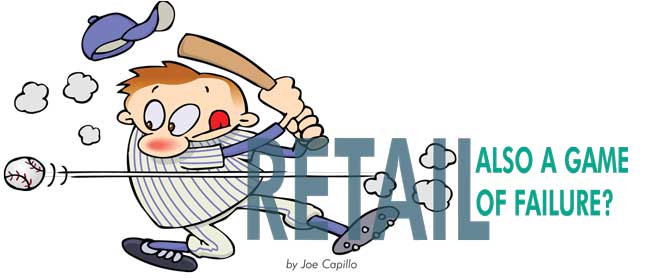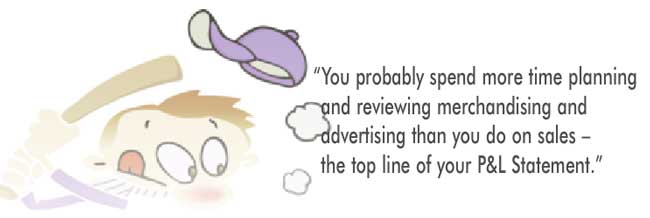
I’ve long said that furniture stores should be managed like sports teams. All teams I follow in professional sports have a lot of coaches to help their players perform at peak levels. Think about it: Baseball teams have a team manager, a hitting coach, a pitching coach, a fielding coach for infielders and outfielders, a bench coach, a first base coach, and a third base coach. Football teams have a head coach, offensive coordinator, defensive coordinator, and other more specialized coaches for just about every position on the team.
In individual sports like tennis and golf, every player has a coach to help them play better.
Furniture retailers have a group of individual “players” who go one-on-one with shoppers to convert them to customers, and in typical situations all the company’s revenue is dependent upon the individual skills of these players – your salespeople. Stores have a sales manager, and perhaps an assistant sales manager supported by players in merchandising, purchasing, display, logistics, and, of course, finance.
In professional sports, players have been coached – taught – from childhood how to play the game, and their chosen position. They’ve been through countless one-on-one sessions to teach them how to think about their role, how to execute under countless possible scenarios. Professional players practice constantly – and they’ve done it since the day they began playing.
Then there’s this: Every sports team has a game plan, a strategy – a “way we play” that is taught, and drilled into each player in countless meetings and training sessions – outside the game.
On game day or match day, all the coaches are right there – where the game is being played, observing each play, each player, each situation from the point-of-view of their game plan and that of their opponent. Adjustments are made on the fly, from one play to the next, or during time-outs.
Every play is measured, recorded, reviewed, and used to make necessary changes to the plan of action. Of course, our game is played every day, but that makes it even more potentially rewarding financially.
Someone once described our kind of retailing as consisting of “long periods of mind-bending boredom, followed by short bursts of intense excitement.” I agree.
Let me pose some questions:
- Do you have a game plan? a “way we do things here.” A “Here’s how we deal with customers.” Is it situational in nature? Like “What if…?”
- Is the game plan written out and fully documented so the “players” can see it, learn it, practice it and understand it?
- Do you talk-the-talk and walk-the-walk every day – all day?
- Do you have a coach, or coaches, whose role it is to ensure that your selling strategy – your “game plan” is actually executed on the floor?
- If you have a “game plan”, a way-to-work-with-customers, do you allow for practice?
- If you have no such plan, who actually controls your business at the point-of-contact?
- Do you control your sales floor using all the above tools, or do you just open the door, and then add up the sales at the end of the day to see what happened?
- Can you review each customer contact (play) after the day is over?
- Where are your sales managers while the “game” is being played?
- Who is observing, listening, coaching during the interactions with your prospective customers?
Baseball has been described as “a game of failure”. A .200 hitter lasts a few years. A .300 hitter goes into the hall of fame. Failing 70% of the time as a batter gets you a plaque in Coopersburg! Why? Because the difference between 20% and 30% is 50%!
For you, this means that if your store has a 20% close ratio overall (not at all uncommon) and you can improve it to 30% - moving from failing 80% of the time to only 70% of the time, your sales volume goes up by 50%. You don’t need any additional shoppers; you just need to perform better with the ones you get.
But, how do you systemically close more sales? First, of course, you need a selling strategy, a “way we do things here.” Next, you need the complete commitment of the owner, president, or whoever is at the top of the company. Not just a wink or nod, but a blood and guts commitment, that this is the right way to serve your customers.

Next, you need a coalition of all managers to drive the strategy every day in every store with every “player” to talk-the-talk and walk-the-walk. You need to teach, and your salespeople need to learn the strategic and tactical things they have to do every day with every customer, and you have to allow for practice, practice, practice through post-engagement reviews and more training as needed. If you want salespeople to sketch rooms to advance their connection to what customers really want, review their sketches. If you want contact information about shoppers who do not buy, conduct daily reviews with each salesperson. It’s a simple thing to set up a methodology for this so that your “game” is reviewed and everyone is held accountable for tactically delivering your strategic plan.
If you want your salespeople to say certain things to your customers, write the dialog you want used, and make time for practice. Then, observe the action on the floor, and reward compliance and effort to deliver what you want. Again: practice, practice, and practice.
When you think about your business strategically, you probably spend more time planning and reviewing merchandising and advertising than you do on sales – the top line of your P&L Statement, from which your bottom line evolves. Remember that 50% difference between closing 20 sales for each 100 shoppers you get, to closing 30 sales. Even improving from 20% to 25% brings a 25% increase in sales with no additional advertising expense required – just better performance.
If your sales managers – coaches on the field of play – are more involved in administration or merchandise issues, or service – or anything that takes them off the field of play, change that now! Look at the huge opportunity you’re missing for more revenue because no manager or coach is really involved in every play on the field.
If your store’s overall closing ratio is 20% you probably have wide variation among individual salespeople. In a typical operation a larger number – usually more than half, will be below that level – some far below. These people need and deserve help, and your selling strategy is their guide to achieving success for these team members. Your sales coaches are the people responsible for having your strategic selling plan executed on the field – your selling floor. There’s way more opportunity for more sales than you may think.
Joe Capillo is a 41 year career veteran, experienced in managing and consulting with furniture retail operations. He is also a contributing editor for Furniture World Magazine. He is a contributing editor to FURNITURE WORLD and a frequent speaker at industry functions. See all of Joe’s articles on the furninfo.com website.